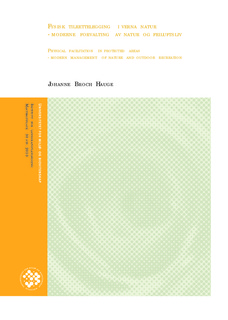| dc.contributor.author | Hauge, Johanne Broch | |
| dc.date.accessioned | 2010-12-01T12:30:25Z | |
| dc.date.available | 2010-12-01T12:30:25Z | |
| dc.date.issued | 2010-12-01T12:30:25Z | |
| dc.identifier.uri | http://hdl.handle.net/11250/188060 | |
| dc.description.abstract | Denne oppgåva har som mål å finne ut om ein kan nytte fysisk tilrettelegging som verkty i forvaltinga av verna natur, for å kunne imøtekoma både friluftslivs- og verneinteresser på same tid. Dagens praksis med tilrettelegging er svært variabel, så dersom ein skal innføre fysisk tilrettelegging som eit verkty i forvaltinga av verna natur må det utviklast klårare retningslinjer for korleis tilrettelegginga skal utførast. Summary
Outdoor recreation is a widespread activity in Norway, and has great value for both the individual and the society. Hiking in the mountains and protected areas is a popular activity and there is an increased political commitment to tourism in conservation areas. At the same time there is increased attention to the protection of nature and conservation of biological diversity.
This thesis aims to find out whether you may use a physical facilitation as a tool in the management of protected nature, to meet both outdoor recreation- and conservation interests at the same time.
The assignment consists of a theoretical part, a sample study and a discussion- and concluding part. The theoretical part describes what outdoor recreation is, the distribution of the activity, and the importance of outdoor activity, for both the individual and the society.
Further, it is discussed how the management of outdoor recreation and nature conservation is organized. It is described how outdoor activities may affect the nature, and what preventive measures the administration can initiate, to prevent the destruction of nature and at the same time facilitate the accessibility of outdoor recreation for its participants.
The sample study draws out examples of wear and physical facilitation in the marginal zones and protected areas. Jotunheimen National Park and the area around the popular Besseggen, located in the park, are further described to provide examples of what a conservation area is and how the use is.
Finally, the methodology, theory, sample area and issues are set up against each other in the discussion- and conclusion section. Here it comes out that physical facilitation, also beyond simply marking and signs, such as for example rock steps on paths, may be a useful tool in the management of outdoor recreation and nature conservation. The use of physical facilitation may both protect the national and international goals of nature conservation and biodiversity, while one paves the way for people to get outdoors, gain knowledge about nature and develop good attitudes to nature and nature conservation.
However, it turns out that the current practice of facilitation is highly variable, and does not hold a steady high level. To impose physical facilitation as a tool in the management of protected nature, it must be developed clearer guidelines for how the facilitation should be performed. | en_US |
| dc.language.iso | nno | en_US |
| dc.subject | Områdevern, friluftsliv, slitasje, tilrettelegging, forvaltning. | en_US |
| dc.subject | Protected areas, outdoor recreation, resource impact, facilitation, management. | en_US |
| dc.title | Fysisk tilrettelegging i verna natur. Moderne forvalting av natur og friluftsliv. | en_US |
| dc.title.alternative | Physical facilitation in protected areas. Modern management of nature and outdoor recreation | en_US |
| dc.type | Master thesis | en_US |
| dc.subject.nsi | VDP::Agriculture and fishery disciplines: 900::Agriculture disciplines: 910::Management of natural resources: 914 | en_US |
| dc.subject.nsi | VDP::Social science: 200::Urbanism and physical planning: 230::Landscape planning: 236 | en_US |
| dc.subject.nsi | VDP::Medical disciplines: 700::Health sciences: 800::Other health science disciplines: 829 | en_US |
| dc.source.pagenumber | 164 s. | en_US |
